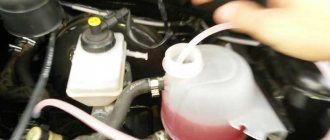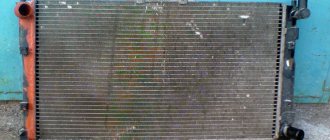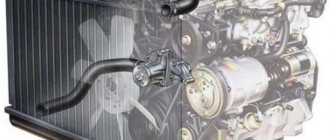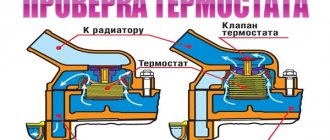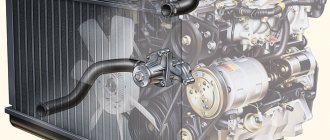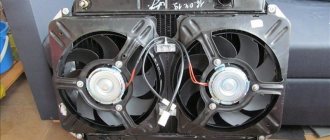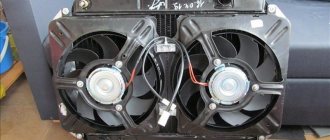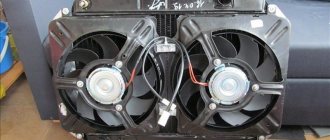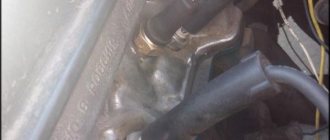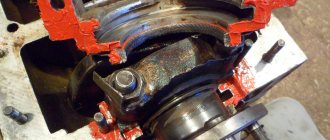When air gets into the cooling system of the internal combustion engine, then during its further operation such a malfunction can cause serious consequences. The safest thing is if there is overheating and this will cause the stove to simply warm up the interior slightly.
If you start the problem of airing the system, then other parts of the car system may break down. That is why you should know how to remove an air lock with your own hands. Even a novice motorist can cope with this task; in this article we will examine in detail the topic of airing the cooling system.
How to determine engine overheating
The fact that this particular “trouble” occurred can be determined by several signs:
- Either the red indicator lights up on the dashboard, or the temperature gauge rises noticeably. This indicates the motor is heating up;
- The engine is boiling, and the heating air is cold;
- Experienced drivers will immediately determine that there is a fairly large temperature difference in the upper pipe along with the lower one.
The presence of air in the cooling system is not just an annoying nuisance, but a catastrophic fact that many inexperienced drivers simply may not notice or not pay due attention to. The consequences manifest themselves much later, when you have to stop in the most unexpected place, seeing steam escaping from the hood.
Many manufacturing companies, unfortunately, no longer provide temperature indicators with an arrow in their cars. Although sometimes the presence of such is not always able to protect drivers from such problems.
Reasons for appearance
There are several reasons why air accumulates in the cooling system channels. An air lock is formed due to:
- System leaks. Leaks at the junctions of the pipes lead to the fact that when the liquid flow moves, a vacuum is formed, which sucks air into the system. Gradually the amount of air increases, then it accumulates in one place, forming a plug.
- Loss of tightness in the water pump. If the sealing gasket under the pump is damaged, the unit will suck in air during operation.
- Violation of technology for replacing or adding antifreeze. If you immediately pour a large amount of liquid, the air in the pipes will not escape and the antifreeze will push air bubbles into the system with its own weight. After starting the engine, the air will gather in one place, interrupting the flow.
- Damage to the cylinder head gasket due to overheating. If the resulting breakdown connects the cooling system channel to the atmosphere, the liquid will draw in air from outside. Airing appears if a breakdown connects the channel to the cylinder. In this case, exhaust gases will break into the cooling system, which, in addition to the appearance of an air lock, is accompanied by the bubbling of antifreeze in the expansion tank.
If you suspect that a plug has formed in the cooling system, first make sure that air has occurred. Overheating of the power plant occurs due to jamming of the thermostat, which is also an unpleasant situation.
What causes engine overheating?
When the temperature reaches its maximum value, along with the presence of a high level of pressure, a breakdown most often occurs in the intermediate partitions of the propulsion systems and their gaskets.
Not only the cooling system suffers from this, but also the lubrication system, gas distribution system and others.
- Significant overheating temperatures bend the head of the block where the cylinders are located. When overheating, this is the most common malfunction when the head becomes like a propeller.
- The head gasket eventually breaks down, causing coolant or oil to leak into the cylinders. After which, both scuffing and water hammer and similar “surprises” are possible, which lead to the vehicle being subjected to major repairs with very unpredictable costs.
To prevent the formation of an air plug, you should constantly carefully monitor the instrument readings.
How to bleed air
There is another method, which is most practical for a unit with a working volume of 1.6 liters. Since in this option air accumulates at a high point. Therefore, the air plug is removed from the throttle assembly.
Accordingly, you will need to use the plastic cover located on the unit itself. You will have to unscrew the cap to add oil. After completing the steps, you will need to remove all the pads, which are held in place using a special rubber seal.
Closing the lid for filling liquid, that is, oil, is quite easy and simple. Once the hose is found, you will need to carefully remove the clamp. Naturally, you should blow into the pipe so that the air comes out completely. Then, you need to quickly insert the hose to avoid air getting inside. By carrying out testing, you can verify the serviceability and functionality of the unit.
Causes of traffic jams
There are certain types of malfunctions in which the system becomes airy. For example, its depressurization. It appears in different places. This may be a hose, pipe or fitting. Often the cause is damaged tubes.
- In addition to the fact that it can be caused by mechanical damage to some parts, they may simply wear out by this time. Also, the reason is often a decrease in the pressure level in the system.
- In the case when, after removing the air plug, signs of its presence appear again, this can only mean one thing, again the reason is depressurization of the system.
- Next, we are talking about repeating the diagnosis, as well as performing a visual inspection to identify the location of the damage.
Any of these reasons can cause harm to both the vehicle’s mechanisms and its components. Basically, the lack of normal cooling leads to overheating of the engine system and its operation, since wear-resistant characteristics can be reduced to a minimum.
In addition to the fact that its main parts are subject to deformation, parts of the seal may gradually fail. The most dangerous thing is if the engine seizes.
The presence of an air lock makes the stove inoperable due to poor circulation of antifreeze, without which there is no sufficient heat production.
In order to cope with such a problem, there are several effective methods that differ in both complexity of execution and method. The only similarity is that they use the fact that liquid is heavier than air.
Signs of air in the engine cooling system
How can you tell if something is wrong with your car’s cooling system? The first thing you should do is listen to how it works and simply inspect it visually. We have identified the main symptoms of malfunctions:
- The pump makes a lot of noise when operating. If it begins to fail and some structural elements break, then it makes loud sounds during operation.
- Antifreeze leak. If there is a defect somewhere in the system, then an antifreeze leak can be easily detected even without a magnifying glass. Carefully inspect the engine and chassis of the car; stains from dried or fresh coolant will be visible on it.
- The stove is malfunctioning. Of course, there are a huge number of reasons why the stove may work poorly or stop heating altogether. But malfunctions can also occur due to the fact that there is an air lock in the system. A more detailed examination is needed here.
- Difficulties in the operation of the thermostat. When the CO (cooling system) activates extremely quickly after starting, it is most likely due to the fact that the thermostat is broken. In almost 80% of cases, malfunctions occur precisely because of a thermostat failure. Also, the thermostat may stop working if air gets into the pipes. Then the following happens - the valve is not constantly closed due to a small air lock, and therefore the antifreeze circulates only in a small circle. If you find that the engine is already very hot, then there are only two reasons: the thermostat has broken or it has become airy.
If you determine that at least one of the above signs suits you, then you need to conduct a full diagnostics of the CO at a car service center as soon as possible. But before that, you still need to determine the reasons, since many of them can be eliminated with your own hands.
First method
The actions are performed in the following order:
- The expansion tank is “released”, where cooling liquid is present. To do this, all elements are completely removed from it;
- Any of the pipes must be disconnected;
- The lid is removed from the tank and it is covered with a piece of cloth;
- Now you need to blow inside the tank to create a certain pressure. This will allow excess air to escape from the pipe;
- When the antifreeze starts to come out, the pipe is put on it and fixed with a clamp;
- The tank lid is closed, and all elements are installed in their places.
How to remove an air lock in the cooling system
Let's move on to the most interesting part - how to bleed air from the cooling system. There are several main ways to solve this problem, which involve completely different algorithms of action.
Method No. 1
The first option, which allows you to remove the air lock from the cooling system, is used as follows:
- All structural elements that interfere with access to the antifreeze tank are removed from the internal combustion engine.
- The pipe used to heat the throttle is removed.
- The lid is removed from the tank, after which the hole is covered with a piece of cloth. Do not use fabric that is too thick.
- Next you need to blow inside the tank. This way you can create an increased level of pressure, causing the remaining air to escape through the open pipe.
- When liquid starts flowing, you immediately need to put the pipe back on and install it securely.
- Return engine parts to original position.
Method No. 2
If you are interested in how to remove air from the cooling system using the second method, then for this you will need:
- Turn on the engine for about 15 minutes.
- Dismantle the internal combustion engine parts as in the first method.
- Remove any of the pipes. The open hole will begin to blow air out. When the antifreeze flows out, quickly mount the pipe to its original position.
This option must be carried out quickly and carefully. The liquid temperature often reaches 90 °C, so contact with antifreeze is undesirable.
Method No. 3
The last method to learn how to remove air from the cooling system provides the following algorithm of actions:
- You need to park the car so that the top of the radiator is higher than the rest of the coolant elements.
- It is important to secure the position of the car with special stops or, at a minimum, to put the vehicle on the handbrake.
- The internal combustion engine starts for 15 minutes.
- Parts are removed to access the antifreeze tank, as well as the caps from the tank and radiator.
- The accelerator pedal is used, and antifreeze must be poured into the radiator. Bubbles will appear on the surface of the liquid, which means that air is leaving the CO.
How do you know that you managed to get rid of the airlock using the third method? It is enough to turn the stove to maximum. When the valve is fully open and the interior temperature begins to rise rapidly, the plug will be completely removed from the cooling system.
The last method of removing air from the stove is an excellent option for those cars where the fan starts automatically. You don't even have to use the accelerator pedal. Just start the engine, intensive circulation of antifreeze using pressure will relieve the system from the blockage. The main thing is to periodically add antifreeze so that an air lock in the radiator does not form again due to free space.
As you can see, bleeding the cooling system is not particularly difficult. Since antifreeze is heavier than air, it is enough to create a hole and a certain level of pressure so that the plug leaves the CO.
Despite the simplicity of the methods, it is best to simply prevent air from entering the lines through which antifreeze circulates. To do this, pay attention to the basic tips for caring for CO.
Method two
Algorithm:
- After starting, the engine is given about fifteen minutes to run, and then it turns off;
- The tank is “freed” from the elements;
- Without removing the cover, any of the pipes is disconnected. If there was excess air, it will come out;
- The pipe is put in place after the antifreeze liquid begins to flow.
This will reduce the risk of an air lock.
If you adhere to the rules of car operation, you can significantly reduce the risk of an air lock in the car. These recommendations look like this:
- compliance with the requirements of the service book for undergoing technical maintenance;
- checking the coolant level at least once a month;
- Fill only with recommended, high-quality coolant. Very often, if low-quality coolant is used, the system becomes airy.
Bottom line
It's time to take stock. The cooling system in every car plays a major role in providing the necessary cooling and maintaining the desired temperature of the internal combustion engine, and is also responsible for heating the interior. If you carry out scheduled maintenance on time and monitor the coolant level, then problems with the engine will not arise. After all, if airing in the system is not noticed and eliminated in time, this can lead to serious problems, in some cases to a major overhaul of the internal combustion engine.
Third method
The algorithm for the third method of getting rid of an airlock comes down to the following:
- The front part of the car must be raised, for which the vehicle is placed on a small hill. The radiator cap, in this case, should be higher than other parts of the cooling system. The machine is secured with a hand brake and chocks under the wheels;
- The engine “runs” for about ten or fifteen minutes;
- The covers must be removed from the radiator and tank;
- The accelerator pedal must be pressed from time to time, while simultaneously replenishing the radiator with cooling liquid, monitoring the release of air from the system in the form of bubbles.
- This continues until the air is completely released. The stove turns on as much as possible. When the air becomes hot, it means the thermostat has opened fully and air has escaped.
Air removal methods
If you observe on the dashboard that the operating temperature of the engine is constantly exceeded (100 degrees or more), follow a number of steps to identify the problem:
- examine the joints of the pipes, the water pump and the expansion tank for leaks;
- check the fluid level in the tank;
- make sure that the cabin heater is functioning properly;
- If the temperature sensor is installed outside the cylinder head, check the operation of the electric fan by closing the contacts.
Before bleeding the cooling system, it is necessary to eliminate all leaks, if any are found. A water pump seal that has lost its seal should be replaced (as a rule, together with the pump), hose clamps should be tightened, and so on. There is no point in removing an air lock from a leaking cooling system.
Checking the heater and fan sensor will help you more accurately determine the location of the air bubble. When the engine temperature reaches a critical threshold and the heater does not heat up, it means that the plug is in a small circulation circuit - in the stove itself or in the supply pipes. If the sensor does not turn on forced airflow in time, then it has entered an area where the movement of antifreeze has stopped - the bubble is in a large circuit.
Method one - blowing
This simplest method requires caution from the car enthusiast, since it is performed on a fully warmed-up engine. The order of operations is as follows:
- If necessary, add fluid to the minimum level and warm up the power unit to operating temperature. Carefully unscrew the cap of the expansion tank.
- Wear gloves and disconnect the thin coolant pipe at the highest point. For an engine with an injector, this is the throttle valve heating unit; on a carburetor engine, it is the intake manifold or the lower part of the carburetor itself.
- Wipe the reservoir neck thoroughly. Place a wide bowl under the removed hose and blow into the expansion tank. When clean antifreeze flows from the pipe, put it on the fitting and secure it with a clamp.
If your vehicle has a thermostatic main radiator cap, try removing the air lock through it. Open both plugs and blow into the neck of the expansion tank.
Method two - complete replacement
This option is suitable for all cases when it is not possible to detect and push a bubble out of pipelines. The point is to completely empty the system and fill it back with antifreeze, following all the rules. The disadvantage of the method is the difficulty of implementation in road conditions.
The procedure is performed in the following order:
- Drain the antifreeze into a wide basin, placing it alternately under the plug on the cylinder block and the main radiator.
- Replace all caps and tighten them.
- Loosen the clamp and remove the throttle body or carburetor heater pipe (the highest point of the system).
- Insert a funnel into the neck of the expansion tank and slowly pour coolant in a thin stream. Air will be removed through the removed hose.
- Monitor the moment when antifreeze runs out of the pipe and immediately put it on the fitting.
Before emptying, be sure to fully open the cabin heater tap.
When the throttle (or carburetor) heating hose is put on and secured with a clamp, add fluid to the container to the required level. Next, check the functionality of the cooling by completely warming up the engine until the thermostat opens and the electric fan turns on.
Method three - road
When faced with overheating of the power unit on the road, try to remove the airlock using this method:
- Having secured the car with the handbrake, lift the front part with a jack to a height of 0.3–0.4 m.
- Slowly unscrew the expansion tank cap, start the engine and turn on the cabin heater to maximum mode.
- Pour antifreeze into the tank in a thin stream until its level reaches the upper limit. Increase the crankshaft speed to 3000 rpm and wait until it warms up completely.
- Squeeze the lower hose leading to the radiator with your hand. The air should escape through the expansion tank. Use gloves or thick cloth to avoid getting burned.
The procedure ends when air stops coming out of the tank. Feel the remaining pipes - they should warm up. Make sure the stove produces a hot stream.
To avoid having to fuss with removing air pockets, always fill in antifreeze according to the instructions described in the previous section. This is the best way to force air out of the system. Fix leaks in a timely manner, do not drive with endless additions of coolant.
Fourth method
If the car has a fan for cooling the system, which operates automatically, then re-gasping is not necessary. Simply letting the engine warm up is enough.
Then wait until the fan turns off. In this case, there is an increase in the movement of the cooling liquid, the circulation of which removes air from the system.
In this case, liquid is periodically added to the system so that airing does not recur.
Important tips for prevention
To avoid cases where air gets into the system, you should always check the presence of antifreeze in the system and periodically add it. If the antifreeze level constantly drops and you are forced to constantly add it, then this indicates that the CO is not functioning properly. Carry out a thorough visual inspection; if you do not find any signs of antifreeze leakage, you should visit a service station to conduct a full CO diagnosis.
Dirty expansion barrel
The system should sometimes be cleaned of contaminants, as it can become clogged with various deposits, both from coolant and from corrosion. The fact is that even small air bubbles in the system can trigger the development of corrosive processes. To clean, you can fill in special liquids instead of antifreeze and drive the car for 5-6 hours, after which the cleaning liquid is drained and antifreeze is added.
Try to buy only the antifreeze recommended by the manufacturer. If you use an untested and unknown liquid, there is a high probability that this will negatively affect the performance of the entire cooling system.
Photo instructions on how to remove air from the cooling system
Possible consequences
If a plug in the cooling system has been diagnosed, you should not put off removing it for too long. Impaired coolant circulation will very soon lead to dire consequences. Engine cooling efficiency drops significantly. Operation at high temperatures leads to accelerated wear of unit components. In extreme cases, naturally, there will be deformation and jamming. It will no longer be possible to do without major repairs, and this pleasure is extremely expensive.
The second is problems with the stove. Its functioning directly depends on the complete circulation of coolant. In the summer, a non-working stove will not create any inconvenience, but in winter it will become a real test for the driver. Also, operating a car with an air lock will lead to increased fuel consumption and damage to individual sensors. If you really want to save money, renovate now!
avtoexperts.ru
It was only in the poem about charging that air and water were friends, they walked through life hand in hand and helped each other; in a car cooling system, the proximity of these two components usually leads to problems, sometimes very serious ones. Airing is an insidious disease, it occurs in the bowels of the car, is not noticeable to the eye, and is often difficult to determine, as if something is wrong in the car, but it is not immediately clear what. In addition, it often appears not as a result of the driver’s actions, but due to mechanical problems; the car owner may not even suspect that he has an air lock. However, if it is not always easy to diagnose the presence of air in the system, then removing it is a task that even novice motorists can cope with.
Places of air lock formation. Cooling system pipes for heating the throttle valve
Symptoms
The difficulty of diagnosing an air lock is due to the non-obviousness and subjectivity of the main parameters - engine cooling and the quality of the stove . If there is air in the system, then it will perform these functions worse than it should - the engine will overheat and the interior will not receive enough heat. However, this is not always noticeable to the eye. It’s good when the car has a coolant temperature sensor, it’s easier to see increased values, but modern cars don’t always have it. In addition, the sensor may also begin to malfunction due to air.
The efficiency of the stove does not measure anything at all; everything is based on the driver’s personal perception. Has it gotten colder in the cabin? Or maybe it just seems like it? In addition, no one uses the stove in the summer; for a whole six months one of the signs is irrelevant. Of course, if there is a lot of air in the system, then the deviation from normal operation will be too large, the problem will become obvious, but a small air lock may not be noticed immediately.
It will be noticeable to the driver if bubbling suddenly starts in the expansion tank - this is also a bad signal, so much air gets in that it comes out on its own, but it is very easy to determine the problem.
Bubbles in the expansion tank
Reasons for airing
The fight against air in the cooling system must be carried out simultaneously with the reason for its appearance there. Otherwise, the fight against the air will be reminiscent of a confrontation with a hydra - I removed one plug, two appeared. The most popular reason for air locks is improper replacement of coolant . Not everyone manages to replace the coolant without leaving air in the system. The air lock must be removed after each antifreeze change. It happens that air gets into the system even during trivial topping up, especially if you pour it in a wide stream into a narrow neck, and then immediately close the tank lid. But this is still rare.
Air lock in the cooling system
Other reasons include:
1. Depressurization of the system . A very insidious problem, the system itself is sucking air somewhere. This usually happens at joints. Pipes, fittings, hoses, radiators - there is a lot of this in any car. If a defect occurs at the junction, the pressure in the system perfectly acts as a pump and gradually sucks in air. By the way, depressurization does not always lead to leakage of antifreeze; it often happens that air enters the system, but the coolant level remains in place. How to fight? Looking for a weak joint is not difficult, but it is tedious.
2. Special cases of depressurization may be problems with the pump , which, due to breakdown or wear, begins to force air into the system, or a breakdown of the cylinder block gasket . In the second case, antifreeze begins to enter the engine, and exhaust gases rush into the cooling system. It is in this case that gurgling occurs in the expansion tank. Problems with the gasket are usually easy to notice (at least by the white smoke from the exhaust pipe), but a pump that begins to break down can cause a lot of trouble with minor problems before it reveals itself.
Blown cylinder head gasket
3. The air valve of the expansion tank plug has failed . It also happens that, as a result of a breakdown, the valve begins to work in the opposite direction - it does not relieve excess pressure from the system, but rather allows air to pass through. If in doubt, the plug can simply be replaced.
Disassembled expansion tank cap
Alas, the cause of airing is not always obvious; very often you have to look for the problem, especially if the whole issue is a violation of the tightness. But without this, dealing with air jams is practically useless.
Two ways to remove air
If the cause of airing is clear to you and you have eliminated it, then you can proceed to removing air from the system. Auto mechanics use many different methods, but they all boil down to two variations that are similar to each other - either push out the air using coolant, or expel it through active circulation . Which one to choose and how exactly to do it depends on the make of the car and the design of its cooling system. The principle diagram is the same for everyone, but there are differences in the nuances. Some cars have a special fitting for bleeding air, but some don’t, somewhere the filler plug is located on the expansion tank, and somewhere on the radiator, the majority of cars have one thermostat installed, and some have two, and so on Further. Therefore, today we will rather talk about the theoretical foundations of the methods, but you will need to think more about how to apply them on your car.
Ventilation hole
1. The first method is based on the fact that air is lighter than water and always tends upward, so you just need to remove it from the highest point by “squeezing it out” with antifreeze. The easiest case is if the car is equipped with a special fitting or valve for removing air . They are specially located in the upper pipes. You need to warm up the car so that the thermostat opens and air from the large circle can enter the small circle, and then unscrew the air bleed valve and keep it open until coolant flows out.
If there is no fitting, then its role may be the highest (and preferably small in diameter) pipe in the system. For example, some cars have a heated throttle assembly; there are usually thin pipes there and they are located high - they are well suited for this role. The principle is the same as with the fitting, only instead of unscrewing the fitting, we pull off the pipe, and when the coolant flows out, we quickly put it in place and tighten it. Yes, the accuracy of the work in this case is lower, the requirements for the dexterity and dexterity of the person performing the operation increases, and the loss of coolant will be noticeably higher, but still this is a relatively simple option if you correctly find the pipe to pull off.
Throttle valve heating pipes
2. The second method seems similar to the first, but everything is based on the active circulation of liquid through the system. It is necessary to jack up the part of the car where the expansion tank or radiator filler plug is located, remove the plug, open the heater tap (if there is one) and actively gas it, creating increased circulation. Air will begin to escape through the filler hole, you can see this by bubbles. When the bubbles run out, you need to add coolant to the level. The method is quite effective, but you need to be more careful with it, because it is easy to get burned on hot pipes or antifreeze. In addition, it is not always convenient to both gas and control the air output alone; you may need an assistant.
Experienced mechanics probably have their own variations of this operation; on the Internet we even came across descriptions where it was necessary to blow into the expansion tank, but, in general, the principle is similar, the choice depends only on convenience and the specific car model. You just need to think a little and remember the school physics course.
Author - Alexander Nechaev
Reasons for the formation of air jams
The finished closed-type heating system is sealed, but this does not guarantee the absence of air bubbles. Where does the gas in pipes and radiators come from?
Air appears in the heating system for the following reasons:
:
- The coolant is tap water that has not undergone special preparation - when heated, air dissolved in the water begins to release, and plugs form from small bubbles.
- The tightness of the system is broken, and air is gradually sucked in through loose connections.
- During the repair work, part of the circuit was disconnected by shut-off valves, some elements were replaced or cleaned, and then the coolant was again supplied to the repaired circuit.
- The pipeline was laid in violation of standards - the small angle of inclination of the pipes and improper installation of kinks prevent gas bubbles from entering special devices - air vents. As a result, gas accumulates in problem areas and interferes with the normal circulation of the coolant.
- If the heating system of a private home fills up very quickly (or when the coolant supply is not at the lowest point), the liquid is not able to completely displace air from complexly configured places in the pipeline and radiators.
- Air vents are missing or incorrectly positioned. Also, the reason for the incorrect operation of the air bleed device is its contamination by mechanical inclusions in the unfiltered coolant.
Mayevsky's manual tap on a radiator
It is also worth considering gas formation in aluminum radiators. When metal comes into contact with a slightly alkaline coolant, hydrogen is released, which accumulates at the highest point of the heating device. If the radiator is not equipped with an air vent, over time the gas lock will not allow the coolant to pass freely through the internal channels of the heating device.
How do traffic jams appear?
First of all, it’s worth finding out why plugs form in the engine cooling system. Their main reason is the leakage of the system itself. Air bubbles enter the cooling system from outside and clog the system. In this case, it is better to contact a car service specialist. Remember – prevention is always cheaper than cure, and you should never neglect diagnosing your car’s cooling system.
You can try to cope on your own. When diagnosing on your own, you need to find out where the hole through which air enters is located. The most common places where the cooling system is depressurized are presented below:
- Connections of tubes, pipes and fittings. There are pressure differences, and when it decreases, excess air enters the system, and if there is a large amount, it forms bubbles, forming plugs and clogging the system.
- Expansion tank. If the valve is faulty, it may suck in air at low pressure.
- The pump, or more precisely, a violation of its tightness, can also cause the formation of traffic jams. Please note that depressurization of the pump can lead to its complete failure.
- Cylinder block gasket. Violation of its tightness can cause not only a decrease in the level of antifreeze, but also a large number of other problems. Its main “symptom” is white smoke from the engine. This means that antifreeze enters the cylinder, and the combustible mixture and gases leak into the cooling system. It is very serious. Urgently go to a car service center.
- The radiators themselves are both cooling and cooling (in common parlance - “stove”). In case of defects, they can allow both air into the cooling system and antifreeze in the opposite direction. As a result, plugs appear in the system and the antifreeze level drops. Without creating panic, you need to move towards the service station.
Also quite often problems are associated with the refrigerant used in the cooling system. At that time, when water was poured instead of antifreeze in the summer, it happened that the new refrigerant was mixed with the old one, which was not completely removed from the system during flushing. This happens even now, when replacing one antifreeze with another.
Therefore, when flushing the cooling system, do it carefully and fill in antifreeze as stated in the instructions for its use to prevent bubbles from mixing in the system.
This is interesting: How to start a car in winter? 7 ways to cold start
Often the problem is with the refrigerant itself. Antifreeze produced by the unknown Vasya Pupkin is, of course, cheaper. However, it not only cools the engine worse, but can also delaminate and clog the cooling system. There is a way out - installing an antifreeze filter, but they have to be changed quite often, and replacing a filter is certainly more expensive than the most expensive refrigerant. So it’s better not to skimp on coolant.
There are cases when, even if good antifreeze was added, the cooling system became clogged with air. The new antifreeze still differs from the used one (albeit slightly) both in composition and temperature. In addition, bubbles form when mixed. In general, only drivers of air-cooled cars are fully insured against this misfortune.
